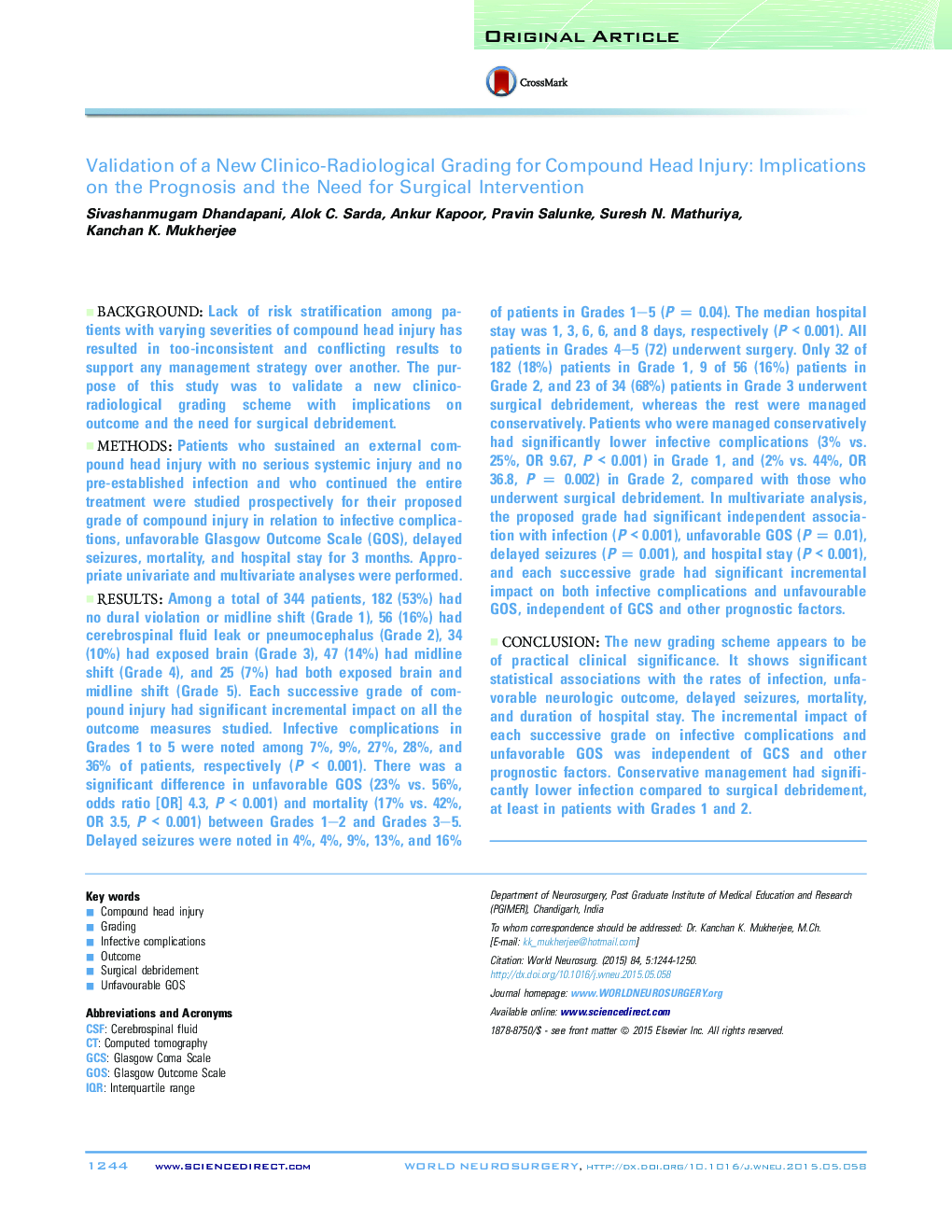| کد مقاله | کد نشریه | سال انتشار | مقاله انگلیسی | نسخه تمام متن |
|---|---|---|---|---|
| 3095154 | 1190903 | 2015 | 7 صفحه PDF | دانلود رایگان |
BackgroundLack of risk stratification among patients with varying severities of compound head injury has resulted in too-inconsistent and conflicting results to support any management strategy over another. The purpose of this study was to validate a new clinico-radiological grading scheme with implications on outcome and the need for surgical debridement.MethodsPatients who sustained an external compound head injury with no serious systemic injury and no pre-established infection and who continued the entire treatment were studied prospectively for their proposed grade of compound injury in relation to infective complications, unfavorable Glasgow Outcome Scale (GOS), delayed seizures, mortality, and hospital stay for 3 months. Appropriate univariate and multivariate analyses were performed.ResultsAmong a total of 344 patients, 182 (53%) had no dural violation or midline shift (Grade 1), 56 (16%) had cerebrospinal fluid leak or pneumocephalus (Grade 2), 34 (10%) had exposed brain (Grade 3), 47 (14%) had midline shift (Grade 4), and 25 (7%) had both exposed brain and midline shift (Grade 5). Each successive grade of compound injury had significant incremental impact on all the outcome measures studied. Infective complications in Grades 1 to 5 were noted among 7%, 9%, 27%, 28%, and 36% of patients, respectively (P < 0.001). There was a significant difference in unfavorable GOS (23% vs. 56%, odds ratio [OR] 4.3, P < 0.001) and mortality (17% vs. 42%, OR 3.5, P < 0.001) between Grades 1–2 and Grades 3–5. Delayed seizures were noted in 4%, 4%, 9%, 13%, and 16% of patients in Grades 1–5 (P = 0.04). The median hospital stay was 1, 3, 6, 6, and 8 days, respectively (P < 0.001). All patients in Grades 4–5 (72) underwent surgery. Only 32 of 182 (18%) patients in Grade 1, 9 of 56 (16%) patients in Grade 2, and 23 of 34 (68%) patients in Grade 3 underwent surgical debridement, whereas the rest were managed conservatively. Patients who were managed conservatively had significantly lower infective complications (3% vs. 25%, OR 9.67, P < 0.001) in Grade 1, and (2% vs. 44%, OR 36.8, P = 0.002) in Grade 2, compared with those who underwent surgical debridement. In multivariate analysis, the proposed grade had significant independent association with infection (P < 0.001), unfavorable GOS (P = 0.01), delayed seizures (P = 0.001), and hospital stay (P < 0.001), and each successive grade had significant incremental impact on both infective complications and unfavourable GOS, independent of GCS and other prognostic factors.ConclusionThe new grading scheme appears to be of practical clinical significance. It shows significant statistical associations with the rates of infection, unfavorable neurologic outcome, delayed seizures, mortality, and duration of hospital stay. The incremental impact of each successive grade on infective complications and unfavorable GOS was independent of GCS and other prognostic factors. Conservative management had significantly lower infection compared to surgical debridement, at least in patients with Grades 1 and 2.
Journal: World Neurosurgery - Volume 84, Issue 5, November 2015, Pages 1244–1250
